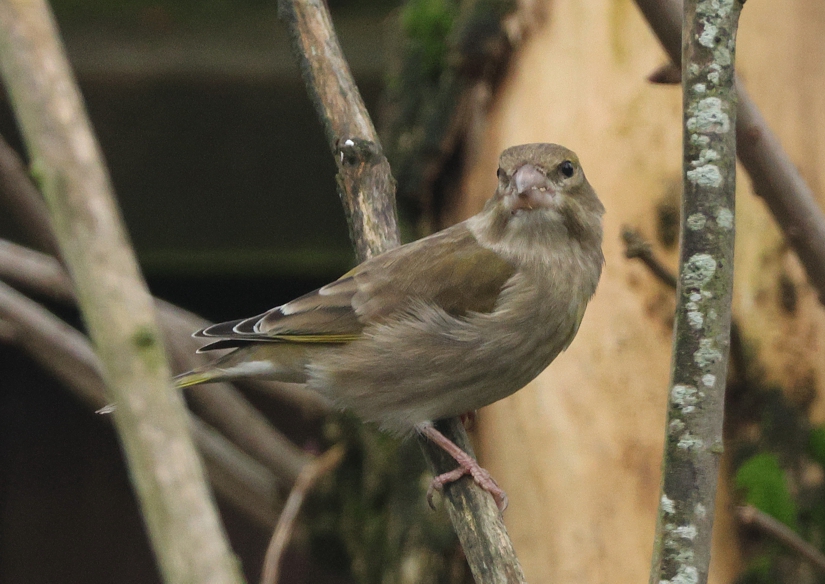I hope you had a great Christmas, and take this opportunity to wish you a Happy and Healthy New Year.
I'm ending the year with an account of my wildlife sightings and photography in the first part of December. This almost exclusively consists of sightings of birds in our garden! I hope that you don't find the lack of variety too boring!
Friday, 1st December Garden
This was a frosty day starting at -3°C and only rising to 0°C, but sunny for most of the day.
During most winters, we get a little fed up with the Starlings that tend to arrive in great numbers, consume all the bird food, and noisily frighten away the smaller birds. It is a relief when, eventually, they depart to somewhere else. However, this year we are seeing very few and are now getting excited when they do appear.
 |
| Starling (Sturnus vulgaris) - our garden |
We were still getting regular visits from Pied Wagtail.
 |
| Pied Wagtail (Motacilla alba yarrellii) (male) - our garden |
 |
| Pied Wagtail (Motacilla alba yarrellii) (male) - our garden |
 |
| Pied Wagtail (Motacilla alba yarrellii) (female) - our garden |
It was frosty again, with -3°C rising to 0°C, but freezing fog and mist for much of day. We were out visiting our son for much of the afternoon. I did manage to get some shots through my study window of a male Pied Wagtail on a frost-free perch only about 7 metres from my seat.
 |
| Pied Wagtail (Motacilla alba yarrellii) (male) - our garden |
Sunday, 3rd December Garden
We awoke to a light covering of snow. The birds were impatient for me to go out and feed them. It warmed a little during the rather dull day, through which it drizzled with rain for most of the time, although some of the snow remained until the end.
 |
| Goldcrest (Regulus regulus) - our garden |
 |
| Blue Tit (Cyanistes caeruleus) - our garden |
 |
| Bullfinch (Pyrrhula pyrrhula) (male) - our garden |
Wednesday, 6th December
There was a very heavy frost in the morning, but the day was sunny, which raised temperature from -5°C to 1°C.
We had two Stock Doves visit on this day. Here is one of them.
 |
| Stock Dove (Columba oenas) - our garden |
 |
| Bullfinch (Pyrrhula pyrrhula) (male) - our garden |
Saturday, 9th December
After two very wet days, the day again started wet, but a few degrees warmer than it had been, rising to 8°C by mid day, when we had some sun. I photographed the Sparrowhawk that alighted briefly in our Rowan.
 |
| Sparrowhawk (Accipiter nisus) (male) - our garden |
Sunday, 10th December
The day started quite bright. In the late afternoon I went to the location of my most recently found Little Owl site, which I had not visited since the spring, and was disappointed to see that the nest tree, and all the other trees on that particular edge of the field, had been completely removed. I had hoped to see some winter thrushes here too, but I only saw about half a dozen Fieldfare as they noisily flew across the road in the far distance.
The only thing I photographed was a heron that had been behind a fence on the far side of a horse paddock, but took flight.
 |
| Grey Heron (Ardea cinerea) - near Normanton le Heath |
A very dull damp day, but having three male Bullfinches visit was exciting. We've had five Bullfinches before (male, female, and three juveniles), but three adult males together was a first. I managed just one record shot with all three in it!
 |
| Bullfinch (Pyrrhula pyrrhula) (male) - our garden |
Wednesday, 13th December Garden
A dull, but mild day. The Sparrowhawk was back.
 |
| Sparrowhawk (Accipiter nisus) (male) - our garden |
 |
| Greenfinch (Chloris chloris) (female) - our garden |
 |
| Bullfinch (Pyrrhula pyrrhula) (male) - our garden |
Dull and wet weather removed any incentive to go out, and I was glad that I stayed at home as we had four wagtails visit that day. The first item that I photographed, however, was a heron on the back neighbours' roof, while we were having breakfast.
Later in the morning, a Bullfinch visited. Without a shadow of doubt, Bullfinch is the most messy eater of all the garden birds!
Grey Heron (Ardea cinerea) -from our house
 |
| Bullfinch (Pyrrhula pyrrhula) (male) - our garden |
 |
| Pied Wagtail (Motacilla alba yarrellii) (female) - our garden |
 |
| Grey Wagtail (Motacilla cinerea) (1st winter) - our garden |
We also had a Stock Dove pay us a visit.
Pied Wagtail (Motacilla alba yarrellii) (male) - our garden

Stock Dove (Columba oenas) - our garden
This brings me to the end of what (for us) was a rather special special day, even if the weather was lousy.
It also brings me to the end of this blog post, which I hope has not bored you with too many images of Wagtails and Bullfinch (both of which are rather special for us) and it just remains for me to wish you all the very best in health and happiness for 2024. Please take good care of yourselves and Nature - - - Richard






















































